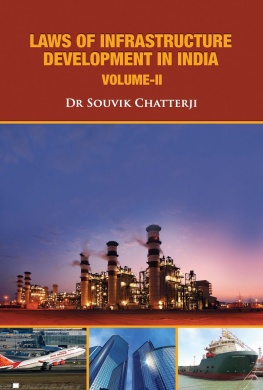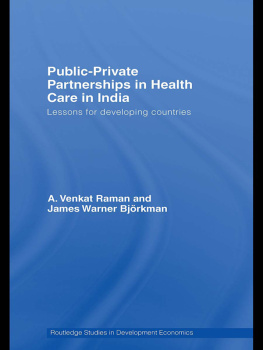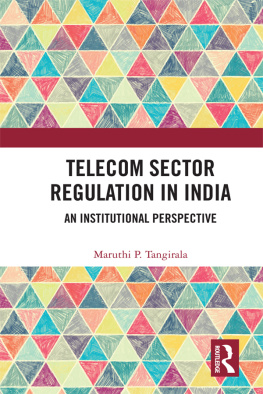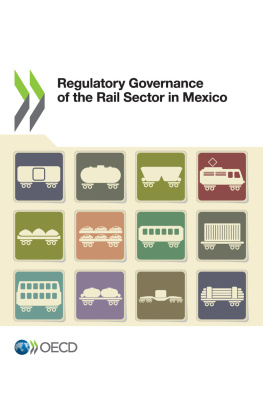
LAWS OF INFRASTRUCTURE
DEVELOPMENT IN INDIA
VOLUME-II
DR SOUVIK CHATTERJI
Editor


Off : F-31, Bali Nagar, Near Ramesh Nagar Metro Station, New Delhi-110015
Tel. No.
Email:
Website: ysbooksinternational.com
Copyright 2015 by Dr.Souvik Chatterji
No part of the book may be reproduced, stored in a retrieval
system, or transmitted in any form by any means, electronic,
mechanical, photocopying, recording or otherwise, without the prior
written permission from the publishers.
The views, content and opinion expressed in the book are the
individual assertion and opinion of the auther and the publisher do
not take any responsibility for the same in any manner whatsoever.
The same shall solely be the responsibility of the auther.
ISBN - 13 : 978-93-837931-9-8
Printed at Mayur Press, New Delhi

I humbly pay my sincere gratitude, regardand respect to the departed soul of my fatherLate Chitta Ranjan Chatterji, Ex-ChiefPublic Prosecutor, CMM Court,Kolkata; and Adjunct Professor in Law,NLU, Jodhpur; who had inspired me towrite this book and without whose guidance andphilosophy the academic work would not havebeen possible.
I also thank my mother Mrs SupriyaChatterji, wife Mrs Rumi Chatterji andson Master Sathvik Chatterji who hadsupported me during the writing process.

Indian Infrastructure Sectors including Airports, Roadways, Telecom Sector, Electricity Sector, Ports, Special Economic Zones, Natural Gas Sector, etc., had developed a lot in the last 15 years after liberalization took place considering the developments all across the world.
Due to utility of these infrastructures in the lives of human beings, there had been demand for developments and expansions of the sectors. Both national and international players are involved in the developments of the sectors and the development require regulatory framework. Those frameworks are provided by the laws relating to infrastructure development. There are many sectoral regulators created in India over the last 10 years to look after the developments in the sectors and also prevent anti-competitive activities and entry barriers in those sectors. A lot of development projects in these sectors are taking place through public private partnerships. The law relating to development of infrastructure sectors require a new look considering the requirements of regulators in the respective sectors.
The regulators are required to balance the strategic dimension of the sectors and also the capital requirement which can lead to development of the sectors. The Book has given overview about the major infrastructure sectors in India. The socio-economic situation of the country has been examined and the need for proactive role to be played by the regulators had also been mentioned. By reading the Book the students can understand the development issues in the sectors, the laws in place, the policies in existence and the interface of the sectoral regulators with the competition watchdog in India, namely CCI.
I would like to thank the editorial team at YS BOOKS INTERNATIONAL, New Delhi for their help and support. I am grateful to team of YS Books for their continuous cooperation, interest and assistance extended to us during the publication.
Halar UtkarshSamity v. State of Gujarat, CivilApplication No. 1778, 5476 and 5928 of 2000, HighCourt of Gujarat at Ahmedabad, decided on 3.8.2000.
Narmada BachaoAndolan v. Union of India AIR 2000SC 3715
Environmental Action Group Case, AIR 2006 SC1489
Bombay Dyeing & Manufacturing Company Ltd. VBombay Environmental Action Group & Others, 2005(5SCC) 61.
Standard Chartered Bank v. Directorate of EnforcementAIR 2006 SC 1301
BabubhaiJashbhai Patel v. Union of India, AIR 1983Guj 1
Centre for Public Interest Litigation v. Union of Indiacase, 78 (1999) DLT 389,406
8. ONGC v. Saw Pipe Case, 17th April, 2003, Case No.Appeal (Civil) 74192001 of 518.
Delhi Science Forum v. Union of India, CWP (PIL)No. 4510 of 1999
Richard Goldwasser v. Ameritech Corporation, USCourt of Appeals, Seventh Circuit, No. 98 -1439,1999.
State of Uttar Pradesh v. Devi Dayal Singh Case, (2000)3 SCC 5
Hyderabad Vanaspati Ltd. v. Andhra Pradesh StateElectricityBoard, JT 1998(3) SC 84
By Dr. Souvik Chatterji
(Assistant Professor, NLU, Jodhpur)
Abstract
The ingredients of natural gas require mention before the Sector and regulations relating to the sector are examined. Natural gas is a mixture of hydrocarbons in gaseous state at normal atmospheric pressure.
It is a combination of methane, ethane, propane and butane and it should be noted that out of these, methane is lighter than air, ethane has approximately the same density as air and others are denser than air.
Natural gas is fast becoming a fuel of choice in the energy market. Like oil natural gas can fulfill a wide range of energy needs. Unlike oil, the costs of handling and transportation are high. Till now the regulator in India dealing with Petroleum and Natural Gas regulates both the sectors. With the increase of responsibilities and demand of natural gas, there is strong demand of an independent regulator in the natural gas industry. The paper examines the need of such regulator in India.
1.1 Introduction
In order to understand what comprises the Natural gas Sector, it is essential to understand what Natural Gas is. Natural Gas is a mixture of Hydrocarbons in gaseous state at normal atmospheric pressure. It is generally a combination of Methane, Ethane, Propane and Butane.
Notably Methane as compound tends to be lighter than air, while Ethane has roughly the same density as air and the other two components, Propane and Butane are both heavier than air. It is found in association with other fossil fuels, in coal beds, methane clathrates and is created by methanogenic organisms in marshes, landfills and bogs. Natural gas has emerged as the most preferred fuel due to its inherent environmentally benign nature, greater efficiency and cost effectiveness. The demand of natural gas has sharply increased in the last two decades at the global level.
In India too, the natural gas sector has gained importance, particularly over the last decade, and is being termed as the Fuel of the 21st Century. Production of natural gas, which was almost negligible at the time of independence, is at present at the level of around 87 million standard cubic meters per day (MMSCMD). The main producers of natural gas are Oil & Natural Gas Corporation Ltd. (ONGC), Oil India Limited (OIL) and JVs of Tapti, Panna-Mukta and Ravva.
Under the Production Sharing Contracts, private parties from some of the fields are also producing gas. Government have also offered blocks under New Exploration Licensing Policy (NELP) to private and public sector companies with the right to market gas at market determined prices. Out of the total production of around 87 MMSCMD, after internal consumption, extraction of LPG and unavoidable flaring, around 74 MMSCMD is available for sale to various consumers.
Next page








